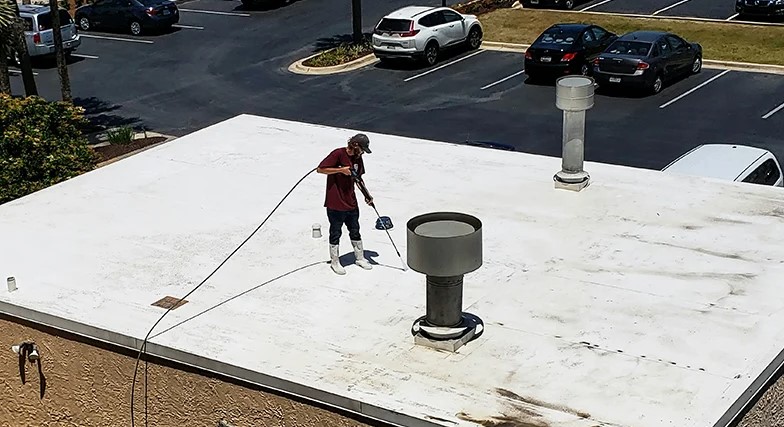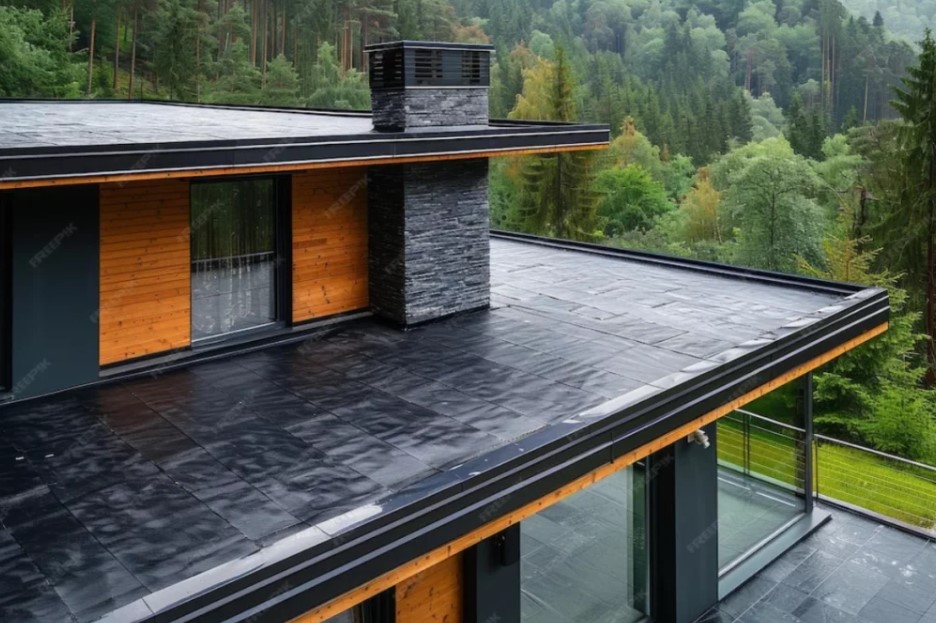Contents
Cleaning a flat roof is essential for maintaining the structural integrity of your building and ensuring its long-term durability. Flat roofs, while practical and economical, tend to accumulate debris, algae, and moss over time, potentially leading to leaks or other damage. Regular flat roof cleaning is a vital aspect of roof maintenance that can prevent expensive repairs in the future. In this guide, we’ll explore safe and effective methods to clean flat roofs, highlight the best tools and techniques, and answer common questions about maintaining a flat roof.
Why Regular Flat Roof Cleaning is Important
Flat roofs, by design, do not have the same slope as pitched roofs, meaning water and debris don’t run off as easily. Over time, leaves, twigs, dirt, and other debris can accumulate, leading to clogged drains and ponding water. This extra weight and moisture can deteriorate roofing materials, making your roof more prone to leaks. In addition, algae and moss growth is common, especially in damp climates, which can further damage your roof’s surface.
A proactive approach to cleaning flat roofs not only prevents these issues but also extends the roof’s life. Debris removal from flat roofs and preventing flat roof leaks are two primary goals of a proper cleaning routine.
Best Time to Clean Flat Roofs
The ideal time to clean your flat roof is during the spring and fall. In spring, you’ll want to clear away any debris accumulated over winter, while fall cleaning ensures your roof is ready to handle winter conditions. Cleaning during these seasons helps keep gutters and drains clear, ensuring efficient water drainage. Additionally, the mild weather makes it safer and more comfortable to work on your roof.
Tools and Techniques for Cleaning Flat Roofs
Before you begin cleaning your flat roof, it’s essential to have the right tools on hand. Here are some common flat roof cleaning tools and equipment that make the job easier and more effective:
- Soft-Bristle Broom or Leaf Blower: A leaf blower or broom is perfect for removing loose debris without damaging the roof surface.
- Pressure Washer: A pressure washer can help clean away dirt, moss, and algae, but use it cautiously to avoid damaging the roofing material. Low-pressure settings are often better.
- Roof Cleaning Chemicals: Using eco-friendly roof cleaning chemicals can break down algae and moss. These chemicals should be safe for roofing materials and the environment.
- Flat Roof Gutter Cleaning Tools: Flat roof gutters need to be clear to prevent water backup. Invest in proper gutter cleaning tools, such as a gutter scoop or hose attachment.

Step-by-Step Flat Roof Cleaning Process
- Safety First: Always prioritize safety. Wear non-slip shoes, use a stable ladder, and have a safety harness if your roof is high off the ground.
- Clear the Roof of Loose Debris: Use a soft-bristle broom or leaf blower to sweep away leaves, twigs, and dirt from the roof’s surface.
- Inspect for Damage: After clearing the debris, inspect your roof for signs of damage, like cracks or worn areas. If you notice any issues, consider flat roof repair and cleaning services.
- Clean Moss and Algae: For areas with heavy moss or algae growth, apply a gentle roof cleaning solution and scrub lightly with a soft brush. Avoid harsh chemicals that can damage the roofing membrane.
- Rinse the Roof: Once the solution has set, rinse the roof thoroughly with a garden hose or low-pressure washer to remove any leftover debris and cleaning agents.
- Clean Gutters and Drains: Don’t forget to clean your gutters and drains. Flat roof gutter cleaning is crucial to ensure proper drainage.
Benefits of Professional Roof Cleaning
While DIY flat roof cleaning can save money, hiring a professional roof cleaning service ensures the job is done thoroughly and safely. Commercial roof cleaning professionals have the expertise and tools needed to clean large or complex flat roofs. They use advanced techniques like soft washing flat roofs, which involves using specialized cleaning solutions to remove dirt without damaging the roofing material.
For homeowners, residential flat roof maintenance services provide peace of mind, especially if you’re dealing with hard-to-reach areas or significant moss growth. Professionals also offer preventive maintenance like roof coating for flat roofs that adds a protective layer, enhancing waterproofing and longevity.
Common Issues to Watch for After Cleaning
Even after a thorough cleaning, it’s essential to watch for common issues that may arise, especially if your roof is older or hasn’t been cleaned regularly. These include:
- Ponding Water: After cleaning, check if water pools in any specific areas. Poor drainage can lead to water damage.
- Clogged Gutters: Even if you’ve cleaned the roof, leaves and debris can still find their way into gutters after a rainstorm. Regular checks help prevent blockages.
- Moss Re-growth: Moss can reappear quickly, especially in humid or shady areas. Consider applying an eco-friendly roof treatment to prevent regrowth.
FAQ: Flat Roof Cleaning
How often should I clean my flat roof?
It’s recommended to clean flat roofs at least twice a year—once in the spring and once in the fall. However, if your area experiences heavy storms or has many nearby trees, more frequent cleaning might be necessary.
Can I pressure wash a flat roof?
Yes, but with caution. Pressure washers can damage roofing materials if the water pressure is too high. It’s better to use a low-pressure setting or opt for soft washing to avoid harm.
Is moss on a flat roof dangerous?
Moss can retain moisture, which may damage roofing materials over time. It’s best to remove moss to prevent long-term issues like leaks or water damage.
Can I clean my flat roof myself?
Yes, with the right tools and precautions, many homeowners can handle basic flat roof cleaning. However, for extensive cleaning or repairs, hiring a professional is always a safe option.
What’s the best way to prevent flat roof leaks?
Regular cleaning and inspections are the best preventive measures. Keeping debris off your roof and ensuring gutters and drains are clear will help avoid water buildup that can lead to leaks.
Conclusion
Maintaining and cleaning flat roofs is critical for the overall health of your building. Whether you opt for DIY methods or choose professional services, regular upkeep will help you avoid costly repairs in the future. By keeping your roof free of debris, moss, and algae, you ensure proper drainage and prevent leaks that could compromise the structure of your home or business.
With the right flat roof cleaning tools, techniques, and preventive care, your roof can last for many years, protecting your investment and giving you peace of mind.
You May Also Read:





